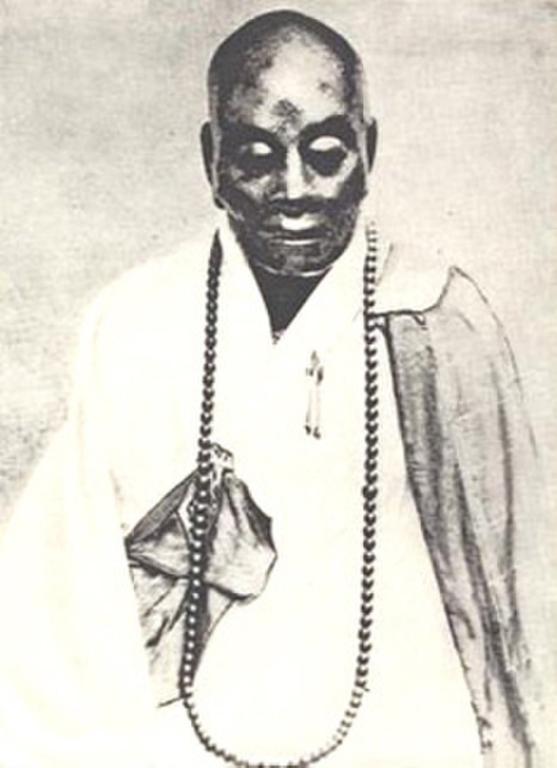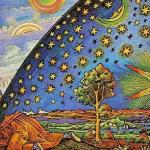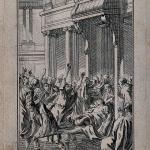
Huineng, First Ancestor
of Chinese Chan (Zen)
An Evolutionary Chronology of Chan
Compiled and edited by Richard Kollmar
and published here with permission
Key: purple = eminent monks; red = important dates and periods; blue = putative Chan masters
Outside of China and before the 8th century CE, no literary or epigraphic evidence supports the existence of an Indian tradition connected to Chan.
………………………………………………………………………………………………………………………………
1st and 2nd centuries CE: Buddhist monks and scriptures reach China. The period of translation and commentary begins.
Kumarajīva (334 – 413 CE), a monk of Kuchea, establishes a center for the translation of scriptures in Changan.
Forerunners and Models (Chan1)
No direct connection to “classical” Chan but may have served as models for the authors of Chan2
Gunabhadra (394–468), translator of the Lankāvatāra Sūtra and 1st patriarch of a lineage that would later be assimilated to the orthodox Chan transmission.
5th century CE: The canon of Buddhist scriptures is complete. The period of sorting and ranking (panjiao) follows. Scholastic traditions develop around sutras and treatises.
Liu Song Dynasty (420–479) Liang Dynasty (502 – 557)
Buddhabhadra (359-429 CE), first translator of the Avatamsaka Sūtra and the Dharmatrata Dhyāna Sūtra (a. k. a. Yogācārabhūmi Śāstra), advocated the dual practice of samādhi and prajñā. His work greatly influenced the development of Tiantai, Pure Land, and Chan doctrine.
A second Buddhabhadra (5th century), first abbot of Shaolin Monastery, whose name and career may have been conflated, a few centuries later, with that of the quasi-historical Bodhidharma.
Daosheng (360 – 434), student of Kumārajīva and co-translator of the Lotus Sutra, held the opinion that enlightenment cannot be realized in stages but is instantaneous and total.
Bodhidharma[1] visits Luoyang in the early 6th century, according to A Record of the Buddhist Monasteries of Luoyang, compiled in 547 CE by Yang Xuenzhi. If he arrived around 500 CE, his activities would have been contemporaneous with those of Zhiyi.
Huike (487 – 593), disciple and sole Dharma heir of Bodhidharma according to later writers.
Sengcan (d. 606), disciple and sole Dharma heir of Huike (?).
(553) The Indian translator Paramārtha and/or one of his disciples composed The Awakening of Faith in the Mahāyana, a treatise that seeks to effect a synthesis of tathāgatagarbha and yogācāra tenets. Tradition attributes the work to Aśvaghoṣa.
Tiantai Zhiyi (532 – 97), third patriarch of the Tiantai tradition and author of several influential works on the cultivation of dhyāna (chan-na) under the rubric of zhiguan (śamatha-vipaśyanā, 止観).
Guanding (561 – 632), biographer of Tiantai Zhiyi, designs the Chan-Master-as-living-Buddha prototype.
[The following figures—historical and legendary—make up the accepted line of one-at-a-time Chinese patriarchs, a list that was not standardized until after the death of Huineng, the nominal 6th: Huike (487 – 593), Sengcan (d. 606), Daoxin (580 – 651), Hongren (601- 674), Huineng (638 – 713).]
Unwitting “patriarchs” and not-quite-Chan (Chan2)
The Sui Dynasty Emperor Wendi (581 – 604) Emperor Yangdi (604 – 618)
Daoxin (580 – 651), disciple and sole Dharma heir of Sengcan (?), is believed to have established the East Mountain Monastery on Broken Head Mountain as a meditation training center.
Encyclopedia of Eminent Monks by Daoxuan (596 – 667) contains entries on Bodhidharma and his putative successors, who lived around 100 years earlier.
The Tang Dynasty (618 – 907)
Period of the Genealogies and Apocrypha
Chan2 as a self-conscious trend, actively working to distinguish itself from dhyāna as practiced in ancient India, emerges during this period. Its authors, the would-be patriarchs (or, more often than not, their disciples or grand-disciples), have not yet developed the encounter-based method that would come to dominate the teaching of Chan3 a century or two later. During this period various groups of Chinese monks compose competing genealogies and Chinese-language “sutras” intended to establish the religious bona fides of the new movement.
Hongren (601- 674), disciple and sole Dharma heir of Daoxin (?).
(685) The Vajrasamādhi Sutra, an apocryphal Korean Chan text, stresses repentance and purification with the aim of perfect enlightenment.
Huineng (638 – 713), neither a monk nor a disciple of Hongren, and yet the latter’s (sole?) Dharma heir.
Shenxiu (606 [?] – 706), disciple and Dharma heir of Hongren and founder of a line active in the western capital for decades.
Puji (651 – 739), disciple and Dharma heir of Shenxiu. 7th patriarch in the line so vociferously impugned by Shenhui.
Shaolin stele (early 8th century), identifies Faru (d. 689) as a direct descendant of Bodhidharma. This is the first linking of Chan and Bodhidharma with Shaolin Monastery. Faru does not make the final version of the list of patriarchs.
Record of the Transmission of the Dharma Jewel by Dufei incorporates Faru bio, names Gunabhadra (NOT Bodhidharma!) as first in the line, advocates for fundamental principles over “demoniac dhyāna.”
(ca. 710)
Huaidi (d. u.) and an Indian or central Asian monk (possibly Pāramiti) translate the Śūraṅgama Sūtra, a curious mixture of Buddha-nature, hetuvidya (logic), yogācāra, and mantrayāna teachings that may reflect the chaotic conditions in Buddhist India at the time of its composition. Its appeal to Chinese practitioners of meditation suggests the broad range of methods practiced by contributors to the various streams of the nascent chan. A compilation of Indian texts, edited for Chinese audiences, its main topics are the importance of samādhi, the distinction between ordinary and true mind, and the matrix of the Thus-come Ones (tathāgatagarbha). The authenticity of this sutra was impugned in ancient times.
(ca. 715)
History of the Masters and Disciples of the Lankāvatāra Sutra [School] by Jinjue (b. 683?) This important text from the Dunhuang cache describes the ideas and practices of the group associated with East Mountain and marks the first appearance of the extended patriarchal line as it would be conceived from this time onward.
Heze Shenhui (684 – 758), putative but doubtful disciple of Huineng, author of Treatise Establishing the True and the False; orator, polemicist, fundraiser, and indefatigable promoter of the Southern school as the sole orthodox lineage of Chan. (One of Shenhui’s disciples is thought to be the posthumous ghostwriter of Huineng’s “autobiography” in the Platform Scripture.) At the Huatai assembly (732) he introduces the doctrine of instantaneous awakening with the aim of stigmatizing gradual approaches as false and ineffectual. His is the single most influential voice in forming the popular view of Chan history. He founded the Heze School, which died out around the time of the Great Buddhist Persecution (842).
Nanyue Huairang (677 – 744), master of
Mazu Daoyi (709 – 788)
Qingyuan Xingsi (d. 740), master of
Shitou Xiqian (700 – 790)
Yixing (683 – 787), foremost disciple of the tantric master and translator Śubhakarasiṃha, was also an adept of Northern Chan, Tientai, and Daoist methods of contemplation. His breadth of practice was not extraordinary for the time and indicates the non-exclusivity and interdependence of the various Buddhist schools during the period before Chan3’s emergence as a distinct, independent tradition.
The Time of the Split
Due in great measure to the oratorical skills and polemical fervor of Shenhui, the artificial distinction between Northern and Southern schools of Chan becomes the common currency of opinion, as does the dichotomy of sudden versus gradual enlightenment.
755 An Lushan Rebellion
Baizhang Huaihai (749 – 814)
Transmission of the Treasure Grove (Baolin zhuan, 801): a compilation of before-and-after-enlightenment biographies.
804 Saicho (767 – 822) visits China, returns to Japan with an early version of Chan.
841 Death of Guifeng Zongmi (780 – 841), fifth patriarch of the Huayen School and (last?) dharma heir in the Heze Chan line of Shenhui.
842 – 45 Buddhism proscribed.
848 Dunhuang oasis abandoned by Tibetans.
“Classical” Chan (Chan3)
Five Dynasties (907 – 960)
Period of the Transmission-of-the-Lamp collections
Anthology of the Patriarchal Hall, 952, is the first in a series of transmission texts.
Song Dynasty: Northern: 960 – 1127; Southern: 1127 – 1279
Period of the Public Record Collections
(ca. 1000)
Tsung-tse writes Principles of Seated Chan (Zuochanyi), the earliest surviving manual of Chan meditation. The text is heavily influenced by the writings on meditation of (Tiantai) Zhiyi (532 – 597) and by the Cultivation and Realization According to the Sutra of Perfect Enlightenment by Guifeng Zongmi (780 – 841). The earliest known version of the “Flower Sermon” appears in 1036.
***
[1] The monk of this anecdote is the first of four possible Bodhidharmas, as follows: (1) Bodhidharma the Indian tourist, (2) Bodhidharma the founder of the Chinese Lanka School, (3) Bodhidharma the founder of one—but not the one-and-only—lineage of chan, and (4) the 28th in a direct line of one-at-a-time holders of Shakyamuni’s wordless Dharma, and the first patriarch of Chan.
***
Richard Kollmar is a former Buddhist monk who leads contemplative walks & pilgrimages in the mountains of California’s Central Coast & teaches meditation. He studied at Fordham University, the University of Hawaii at Manoa, and the General Theological Seminary. His scholarly work focuses on contemplative studies & the philosophy of consciousness.
***













